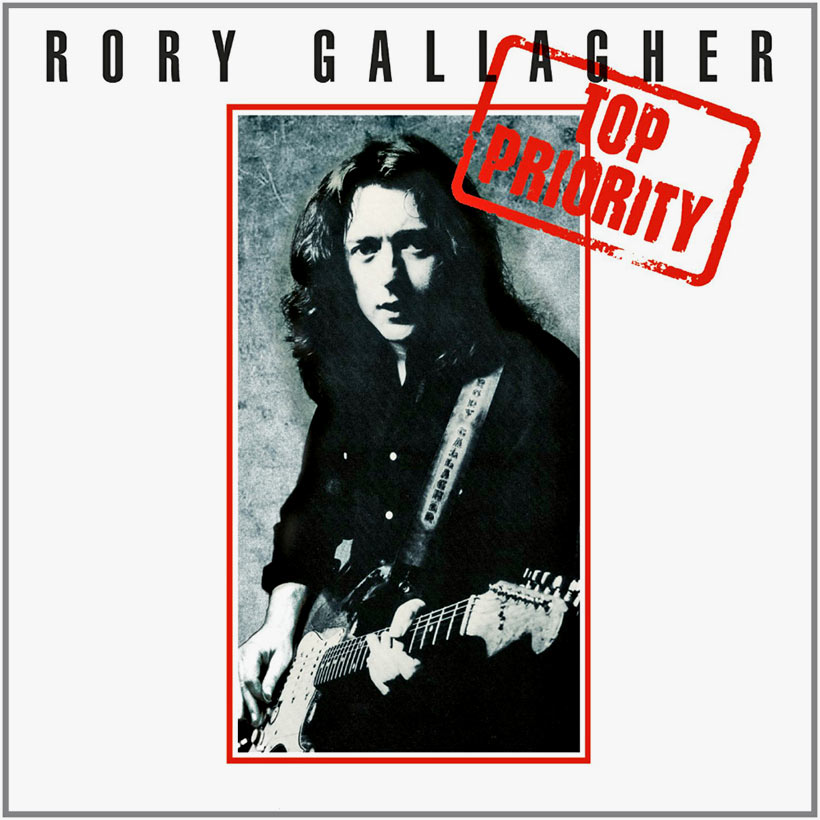It was Rory Gallagher’s then label, Chrysalis Records, who inadvertently named his tenth album. Top Priority, the brisk follow-up to 1978’s well-received Photo-Finish, arrived on the back of a hugely successful US tour which resulted in positive press at home and abroad, provoking Chrysalis into revealing that their “top priority” was the release and promotion of the prolific Irish star’s next album.
Though Gallagher chose the phrase as the record’s title to remind the company executives of their promise, Chrysalis had good reason to support him every inch of the way. They saw he was in fine shape creatively and, as Photo-Finish had already demonstrated, he had the resilience required to sidestep the post-punk era’s revolving door of fads and fashions.
Back to the essentials
Gallagher had, however, made a few changes of his own. He reshuffled his band’s personnel prior to Photo-Finish, retaining longtime bass lieutenant Gerry McAvoy, but stripping the line-up back to a muscular power trio completed by ex-Sensational Alex Harvey Band drummer Ted McKenna. As he told North America’s Record Review in April 1980, he’d found this process reinvigorating.
“There’s something about a three-piece,” he mused. “You’re really back to the essentials, it’s very rhythmic and aggressive, and I like that. With keyboards, you’ve got extra texture and all that, but it cuts down the free-form style. I’m happier in a three-piece band.”
Gallagher’s team had recorded Photo-Finish at Dieter Dierks’ studio outside Cologne in Germany. They decided to return there for the Top Priority sessions as they enjoyed the complex’s relaxed, yet creative vibe. The record they emerged with, however, was every bit as urgent and compelling as its immediate predecessor.
‘I just do my own thing, whatever it is’
Top Priority opened with the anthemic, shape-throwing “Follow Me” and the tracklist was again long on exuberant rockers such as “Wayward Child,” the atmospheric, Southern rock-styled “Bad Penny” and the thrilling “At The Depot,” with the latter number affording Gallagher the opportunity to let rip with some truly imperious slide guitar.
Except for “Keychain” and the smoldering “Off The Handle,” the Cork man’s blues influences were less evident than usual, but several significant stylistic departures more than redressed the balance. To this end, the whole band performed with swagger to spare on the atypically funky, Hendrix-ian “Public Enemy No.1,” while the evocative, noir-flavored “Philby” found Gallagher drawing unlikely comparisons between the notorious double agent Kim Philby and his own restless rock’n’roll lifestyle.
“I love that whole espionage thing,” he told Record Review. “I thought there were some parallels to the rock world. It’s a spy song and he’s the ultimate spy. I added the electric sitar to give it a slightly exotic feel and there’s some mandolin on it also. I hope to do more songs like that, using more unusual themes.”
Making blues-based material come alive
First released on September 16, 1979, Top Priority was quickly embraced by Rory Gallagher’s fiercely loyal fanbase and it soon found favor among the era’s more tuned-in critics, such as Creem’s Michael Davis, whose review sagely noted that “after a decade on the boards, he can still make blues-based material come alive”. Four decades on, that observation still holds true: the exhilarating Top Priority has barely aged a day. Indeed, its inherent freshness shows exactly why this singular performer was always right to follow his heart and eschew the industry’s continual turnover of trends.
“Well, I just go doing my own thing, whatever it is,” Gallagher said in 1980, illustrating this point. “I think it’s modern and valid and moves in its own way. The next thing you get is new wave and that’s not that different, it’s back to basics, which is where I’ve been all along. I think good rock’n’roll and blues are timeless – it’s not a fad.”




